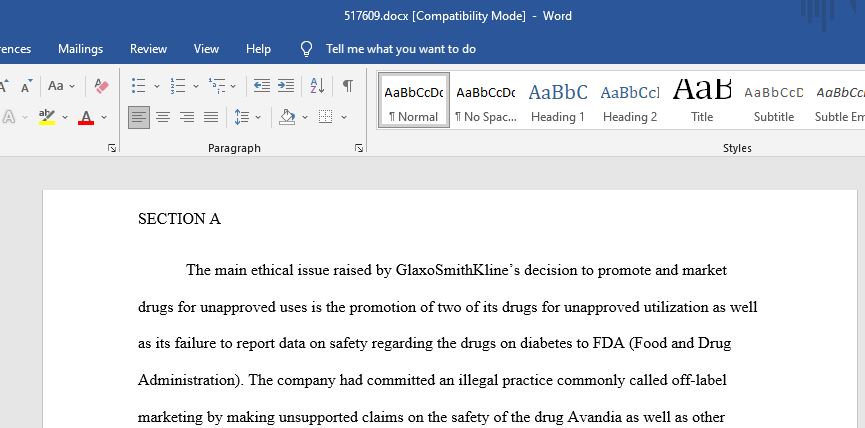-
Ethical issue raised by Glaxo Smith Kline’s decision
- Order Summary
- Type of assignment:Assessment
- Academic level:University Level, Bachelor’s
- Referencing style:MLA
- Number of sources:1
- Subject:Philosophy
- Client country:Australia (UK English)Assignment extract:
Hi there
just following the unit guide of this assessment
thanks but i need really understand and perfect essay
PHIL201 Assignment 1: Moral Reasoning Assignment
Detailed Task Outline
Due date: 17 December, 2017
Length: 700 words
Weight: 20%
The aim of this exercise is to help you become familiar with the techniques of
moral reasoning and to encourage you to think critically about moral issues.
Preparation
• Read the description of the Moral Reasoning Assignment 1 in the
Assessment Guide.
• Make sure you read in detail all the news items and other information
given to you in the assignment question as well as watch the documentary
program (or read the transcript of the program).
• You are not expected to use sources other than those listed in the
questions and any relevant readings from the PHIL201 reading list.
• The most relevant readings are those from seminars 3 and 4: The Nature
of Ethics and Morality; The Nature of Moral Reasoning.
• Review the marking rubric for this assignment.
• Read ‘A Guide to Writing and Referencing Philosophy Essays’. While this
assignment is a short answer rather than an essay assignment, the Guide
has very useful advice relevant to writing in philosophy more generally
and on plagiarism and referencing (in the Assessment section on the
iLearn homepage).
• Read the Macquarie University Academic Honesty Policy (in the
Assessment section on the iLearn homepage).
Answering the questions
• This is a short answer assignment. Do not answer the questions in the
form of an essay.
• Answer the questions succinctly and avoid introducing material not
directly relevant to the question.
• Make sure you answer every part of each question.
• Remember to provide sufficient detail in Section C to give a clear
indication of your overall position with respect to the cases and the
principles you endorse.
• Include a bibliography with the main sources listed in the assignment
questions and any additional sources you reference directly.
• Include citations in the body of the assignment where appropriate.
• You may use any of the major referencing styles provided you do so
consistently. See http://libguides.mq.edu.au/Referencing
Guidelines
The aim of this exercise is to help you become familiar with the techniques of
moral reasoning and to encourage you to think critically about moral issues.
Remember to support your particular moral judgments about these cases with
reasons. You should aim to justify your particular moral judgments using
relevant moral principles and moral reasons. These principles may be very
general, like the principle of utility (‘maximize happiness’), or common
deontological principles concerned with loyalty, promise keeping, or those
prohibiting deceiving and harming others, etc. Aim to achieve a consistent fit
between your moral beliefs, principles and particular judgments. Refer to the
readings for seminars 3 and 4 to find examples of moral principles and reasons
and explanations of moral reasoning and justification.
Assessment Criteria
This task will be assessed by the following criteria:
1. Question
• Does the student show a clear and precise understanding of the
questions?
• How well are the questions answered?
2. Ethical Analysis
• Does the student identify and explain key ethical issues in a clear and
precise manner?
• Are answers adequately supported with reference to relevant ethical
principles, values and reasons?
• Is the use of ethical principles, values and reasons coherent and
consistent with the student’s particular moral judgements and moral
conclusions?
3. Written Expression and Presentation
• Is the written expression clear and concise?
• Is physical presentation of the assignment adequate (in relation to
legibility, line-spacing, spelling, grammar, proofreading, word count etc.)?
4. Referencing
• Acknowledgement of sources (bibliography)
• Correct citation of reference
Answer preview:
Word: 700

